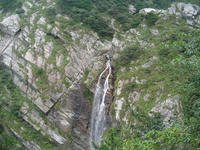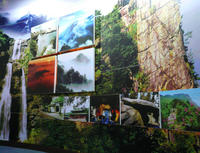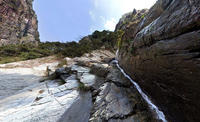You are in: Asia -> China -> Lushan National Park, and traditional search or Image Gallery will yield results of this site only
Lushan National Park
| Site number: | 778 |
|
| Type of site: | Cultural | |
| Date of Inscription: | 1996 | |
| Location: | Asia, China, Jiangxi Province, Jiujiang City | |
Up to 75 images are shown here. Click on each for more details or on Image Gallery for more images.
| Description: | Mount Lushan (located in Jiangxi) is one of the spiritual centres of Chinese civilization, comprised of Buddhist and Taoist temples, along with Confucian landmarks. The most distinguished masters taught within these spaces, effortlessly blending into an outstandingly striking landscape, a landscape which throughout time inspired countless artists - responsible for developing the aesthetic approach to nature found within Chinese culture. --WHMNet paraphrase from the description at WHC Site, where additional information is available. For 360 degree imaging of this site, click here. | |
| Mount Lu (simplified Chinese: 庐山; traditional Chinese: 廬山; pinyin: Lúshān; also known as Mount Lushan) is a mountain in the People's Republic of China, situated south of the city of Jiujiang in Jiangxi Province, near Lake Poyang. Its highest point is the Dahanyang Peak (1.5 km above sea level). The mountain is a prominent tourist attraction, especially domestically. The northwest slope is where Hui-yuan founded Pure Land Buddhism in 402, and features the Donglin Temple. Lushan National Park is a UNESCO World Heritage Site (cultural) whereas Lushan Quaternary Glaciation National Geopark is a member of UNESCO Global Geoparks Network. The Lushan Botanical Gardens features tens of thousands of plant species. Below the Five Old Men Peak is the White Deer Grotto Academy, named after the poet Li Bo(Chinese: 李渤) (not to be confused with the famous poet Li Bai), who raised white deer there. It is amongst the oldest institutes of higher learning in ancient China. West is the Flower Path which provided inspiration to Bai Juyi, a famous poet who lived during the Tang Dynasty. Between the Yangtze River and Lake Poyang lie the Greater and Lesser Tianchi Lakes, the Jingxiu Valley, and Lulin Lake. On the north bank of the latter is the Lushan Museum, which features pottery and bronzes dating from various periods of ancient China, as well as calligraphic works from the Tang Dynasty and paintings from the Ming and Qing dynasties. At the centre (between three peaks), and at an altitude of over 1 kilometer above sea level, is the town of Guling, which is linked by a mountain highway to neighboring spots in the region. --Wikipedia. Text is available under the Creative Commons Attribution-ShareAlike License. For 360 degree imaging of this site, click here. | ||
| Source: | http://whc.unesco.org/en/list/778 | |
| Reference: | 1. UNESCO World Heritage Center, Site Page. | |














